Solomon › Hyksos » Ancient origins
Articles and Definitions › Contents
- Solomon › Who Was
- Hyksos › Antique Origins
Ancient civilizations › Historical and archaeological sites
Solomon › Who Was
Definition and Origins

According to biblical tradition (and some say myth), King Solomon was the third and last king in the ancient United Kingdom of Israel. Other faiths, such as Islam and Rastafarianism, also embrace the notion of Solomon as a sagacious king and powerful prophet of Israel. He was renowned for his wisdom, his prolific writings, and his building accomplishments. Born around 1010 BCE, Solomon was the tenth son of King David (the second king of ancient united Israel) and the second son of Bathsheba.Like King Saul and King David, King Solomon reigned for 40 years in one of the highest and most prosperous periods in Israel's history - called by many, “The Golden Age” of Israel.
During his reign, Solomon controlled the trade routes coming out of Edom, Arabia, India, Africa, and Judea; he constructed an elaborate and profitable web of alliances (cemented by an enormous assemblage of hundreds of wives and concubines), and he purportedly built the first Temple of God in Jerusalem, which was destroyed (along with the entire city of Jerusalem) by the Babylonians in 586 BCE. Despite initial sovereign successes, the end of Solomon's rule was marked by several insurrections and attacks from both foreign and domestic enemies, as well as a disintegration of national and religious integrity because of cultural appeasements within Israel, which compromised and weakened the social fabric of the United Kingdom.He died in 931 BCE at age 80, possibly the most prosperous and productive king ever to rule over Israel.
THE TRADITIONAL STORY OF KING SOLOMON
The story of King Solomon begins with his father, King David, and his mother, Bathsheba. In the Hebrew scriptures, 2 Samuel 3 states that King David, anointed by the Prophet Samuel before King Saul's demise to be his replacement, officially became King of Judea (1010 BCE). Later, 2 Samuel 5 states that (in 1002 BCE) all the elders of Israel approached him to be their ruler, and “The king made a covenant with them at Hebron before the Lord, and they anointed David king over Israel.” King David's reign lasted 40 years, and like King Saul, it started off better than it ended.
THE SCRIPTURES STATE THAT GOD GAVE SOLOMON NOT ONLY KNOWLEDGE & WISDOM, BUT ALSO 'RICHES & WEALTH & HONOR'.
David's initial zeal for God and for ethical integrity paved the way for his early fame and fortune, although being a man of warfare and blood (according to the scriptures), God decided that David was not suitable to be the one to build God's Temple (that would be placed in the hands of his son, Solomon). Moreover, David's illicit affair and subsequent devious actions (leading to the assassination of Uriah the Hittite and its cover-up) complicated the rest of David's reign - along with the rape of Tamar, the murder of Ammon, and the attempted coup of Absalom, among other controversies.
By the end of David's life, he had lost touch with Israelite society and eventually lost political control of it, as well. This led to an attempted coup by his son, Adonijah (whose mother was Haggith, David's fifth wife), who proclaimed himself to be king with the assistance of General Joab and Abiathar the Priest; however, the majority of Israel's institutional agents did not support Adonijah's claim. The Hebrew scriptures state that the Prophet Nathan went first to Bathsheba to alert her to Adonijah's usurpation of the throne, who then went to her husband, King David, to break the troubling news to him. Eventually, the Prophet Nathan joined the two, and King David officially made Solomon his heir apparent. David said, “Assuredly Solomon your son shall be king after me, and he shall sit on my throne in my place” (1 Kings 1).
SOLOMON BECOMES KING
King David died from natural causes in 961 BCE, was buried in Jerusalem, and, as suggested in the Hebrew and Greekscriptures, facilitated the establishment of the eternal kingdom of God through his piety and lineage. Before his death, David gave his final admonition to his son, Solomon, saying, “Keep the charge of the Lord your God: to walk in his ways, to keep his statutes, his commandments, his judgments, and his testimonies, as it is written in the Law of Moses, that you may prosper in all that you do and wherever you turn... for you are a wise man” (1 Kings 2).
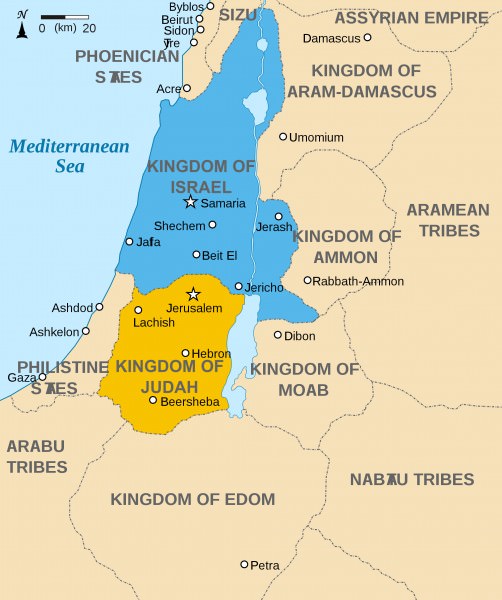
Map of the Levant circa 830 BCE
The threat of civil war and Adonijah's immediate execution as a traitor was averted for a time; however, Adonijah attempted to possess King David's former asexual concubine, Abishag the Shunammite, behind King Solomon's back. This enraged Solomon most likely because of Adonijah's surreptitious political triangulation of Bathsheba and because of Adonijah's political machinations to be following in King David's footsteps. Thereafter, “King Solomon sent by the hand of Benaiah the son of Jehoiada' and he struck [Adonijah] down, and he died” (1Kings 1). King Solomon also dispatched the other ringleaders of the coup - General Joab and Abiathar the Priest, although Joab was executed and Abiathar was exiled.
Perhaps one of the more fantastical yet pivotal parts of the biblical story of Solomon is the divine gift that he received from God as recorded in the Hebrew scriptures. Solomon implored, “Now, O Lord God, let your promise to David my father be established, for you have made me king over a people like the dust of the earth in multitude. Now give me wisdom and knowledge.” According to the Hebrew scriptures, this impressed God, so Solomon received not only knowledge and wisdom, but also “riches and wealth and honor, such as none of the kings have had who were before you, nor shall any after you have the like” (2 Chronicles 1). The Qur'an also indicates that Solomon received a divine gift of wisdom, along with other special gifts (21:78–79) - "And We made Sulaiman [Solomon] to understand (the case); and unto each of them We gave judgment and knowledge."
ACCORDING TO THE HEBREW SCRIPTURES, 'THE KING MADE SILVER & GOLD AS COMMON IN JERUSALEM AS STONES, & HE MADE CEDARS AS ABUNDANT AS THE SYCAMORES, WHICH ARE IN THE LOWLAND' (2 CHRONICLES 1).
FEATURES OF SOLOMON'S REIGN
Solomon's prosperity and success were also achieved through ingenious reforms and innovations such as the improvement of defense measures; the expansion of the royal court; the financial windfall from more sophisticated taxation, labor conscriptions of Canaanites and Israelites, tributes and gifts from foreign countries under the influence of Solomon; and a land and sea trading system that utilized a powerful navy and army to protect assets and trade routes. According to the Hebrew scriptures, “The king made silver and gold as common in Jerusalem as stones, and he made cedars as abundant as the sycamores, which are in the lowland” (2 Chronicles 1).
King Solomon was also famous for his international relationships, forming alliances with other nearby powerful nations such as Egypt, Moab, Tyre, Arabia, etc. Many of these partnerships were cemented through royal marriages and the giving of concubines to Solomon, eventually gaining him 700 wives and 300 concubines. One of King Solomon's more famous political-amorous relationships was with the Queen of Sheba (which some speculate to be modern-day Yemen), who visited Israel with a lavish tribute of 120 talents of gold. The Hebrew scriptures state, “And when the queen of Sheba had seen the wisdom of Solomon, the house that he had built, the food on his table, the seating of his servants, the service of his waiters and their apparel, his cupbearers and their apparel, and his entryway by which he went up to the house of the Lord, there was no more spirit in her” (2 Chronicles 9).
Clearly, the Queen was impressed with Solomon and his accomplishments, and the two cultivated an intimate relationship, with Sheba helping create, foster, and maintain Solomon's trading with other Arabian kings. Additionally, according to the Rastafarian faith, Solomon and Sheba conceived a child together, whose descendants included Haile Selassie I, "the God of the Black race," as Selassie would then be related to both King David and Jesus Christ of Nazareth.
SOLOMON'S TEMPLE
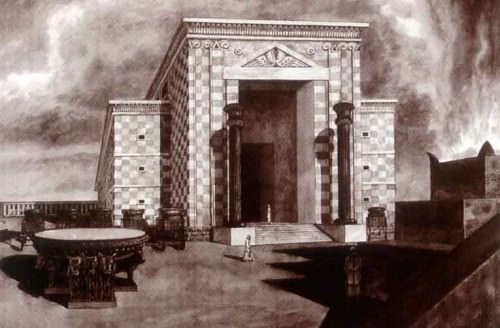
Solomon's Temple, Jerusalem
The architectural design of the Temple was modeled after the tabernacle that had housed the Ark of the Covenant for decades (if not centuries). Quite lavish, it was double the size and built mainly from stone, with cedar paneling to hide all masonry, which was overlaid with gold. The inside of the Temple was decorated with elaborate carvings (gourds and open flowers), golden lampstands, an altar of incense (also called “the golden altar”), and two bronze pillars among other embellishments. In a less-advanced architectural age, at over 100 feet long by 40 feet wide by 60 feet high (30 x 12 x 18 m) with outer doors of ivory, the First Temple must have seemed an impossibility, a miraculous achievement, for most visiting Israelites.
According to the Hebrew scriptures, after the Temple was completed, Solomon had the Ark of the Covenant finally moved from the tent that King David had made for it and placed it in its specialized chamber on the most western end of the Temple called, “The Holy of Holies.” A perfect 20 x 20 x 20 ft. (6 x 6 x 6 m) cube, this was the most sacred room that no one besides the Chief Priest could enter (on the Day of Atonement) without dying. Institutionally and nationally, it was the intersection of the Divine with his People through his mediator. The Temple did not just house the Levitical priests of God. Side rooms and a courtyard were constructed around the whole building, with areas sectioned off for both the priests and the common people of Israel.
Being a builder, King Solomon also engaged in other construction projects such as his personal palace, the Palace of the Forest of Lebanon, the Hall of the Pillars, and the Hall of Justice. Yet, Solomon did not restrict his projects to Jerusalem alone.He also rebuilt several cities ; he commissioned fleets of ships and built numerous harbors to accommodate the bounty of the trade routes; and he constructed stables to house his thousands of horses and chariots. It is even possible that he helped erect (or financed with plunder from the Temple by the Assyrians or Babylonians) the famous Hanging Gardens (one of the legendary Seven Wonders of the World).
SOLOMON'S LITERATURE
King Solomon is also credited for contributing several books and literary works to the Hebrew scriptures including the Book of Proverbs, the Song of Songs, and Ecclesiastes, as well as traditionally penning some extra-biblical works including musical songs, poetry, histories, and scientific works in botany and zoology (although no extant writings have been discovered, currently). Under Solomon, Israel's golden age produced most of the works that were eventually gathered together into the “The Writings” or “Kethubim” section of the Hebrew scriptures.

Model of Herod's Renovation of the Temple of Jerusalem
Although theology is a component of Solomon's writings, the wisdom genre (also seen in Egyptian and Akkadian literature) focuses more on areas outside of theology - providing advice on the created world, relationships, practical matters, and assorted personal topics or challenges. Thus, Proverbs deals with the art of living, with how to make intelligent choices for one's future well-being. The Song of Songs (or Song of Solomon) is a romantic poem that presents the ultimate union between the bride and the bridegroom, focusing on themes of love, wisdom, beauty, power, desire, sex, loyalty, etc. The Book of Ecclesiastes is a royal testament that includes personal reflections, meditations, and instructions on the meaning and purposes of life, alluding to several aspects that would have been relevant to Solomon's own personal experiences - wisdom, futility, riches, servants, hedonism, productivity, and humble self-realization. Although Solomon was the original sage for many of his proverbs, he also searched his kingdom and empire for other writings and ideas of erudite men and included them in his compilations.
Outside of the Hebrew scriptures, writings also exist that are attributed to King Solomon. In the Pseudepigrapha, The Testament of Solomon is a 3rd century CE book that syncretizes magic, astrology, and demonology to discuss the construction of the Temple among other sub-topics. In the Apocrypha, the Wisdom of Solomon is a deuterocanonical collection of wisdom sayings attributed to King Solomon (based on chapter 9:7–8), although the Muratorian Fragment suggests that it was "written by the friends of Solomon in his honour."
LOSING FAVOUR WITH GOD
Despite all these great accomplishments, the Hebrew scriptures indicate that the decline of Solomon was similar to the fall of the previous kings of United Israel - similar, in that personal vanity and religious/moral compromise led to social disintegration and strife. Solomon slowly deprioritized his relationship and obligations to God in order to appease his many foreign wives and in order to protect the prosperity and longevity of his rule. Ultimately, “[Solomon's] wives turned his heart after other gods, and his heart was not fully devoted to the Lord his God, as the heart of David his father had been” (1 Kings 11). Solomon's ungrateful, disloyal actions and attitude - despite being the wisest and most blessed man on the earth - provoked the anger and judgment of the Lord.
Thus, although still able to keep control of the nation of Israel because of God's promise to King David, Solomon lost the protection and favor of God that earlier had provided remarkable peace and prosperity when he was obedient to God.Solomon soon found new challenges from within and without his kingdom, including Jeroboam who was promised to reign over Israel by the Prophet Ahijah, from Hadad of Edom who challenged Solomon's territorial control in the southern territory of Israel, and from Rezon of Damascus, who threatened Solomon's control over the northern territory of Israel.
King Solomon died of natural causes in 931 BCE at the age of 80. His son, Rehoboam, inherited the throne, which led to a civil war and the end of the United Kingdom of Israel in in 930 BCE.
EPIGRAPHICAL & ARCHAEOLOGICAL EVIDENCE FOR KING SOLOMON
As with King David, verifying the existence of King Solomon is challenging, at best, especially since epigraphs typically provide imprecise information, and the biblical accounts rest upon a presupposition of supernatural realities. Although there is much archaeological and epigraphical evidence to substantiate the possibility of some/many (non-supernatural) scriptural assertions, archaeological finds to date have provided mostly indirect affirmation. With such huge gaps in archaeological evidence and with the contamination of too many archaeological fields, it is easy to speculate, theorize, or make an argument from silence, but it is difficult to empirically prove or disprove the existence of Solomon. Still, some provocative-yet-controversial archaeological finds have been recently unearthed over the last century that require consideration.
Although its first discoverer is unknown, in 1828 CE, Jean–François Champollion, who also discovered the Rosetta Stone in 1799 CE, examined the Bubastite Portal gate (built in 925 BCE) at the temple of Amun in Thebes. On its walls, among the historical paintings, a long list of defeated peoples by Pharaoh Shoshenq is accessible, including those from the “Highland/Heights of David,” presumably led by King Rehoboam, which led Champollion to conclude that Pharaoh Shoshenq and King Shishak of Egypt, as referenced in 1 Kings in the Hebrew scriptures, are one and the same.
In 1868 CE, Missionary Frederick Augustus Klein discovered an intact stele in Dhiban, Jordan, called the “Mesha Stele” or the “Moabite Stone,” with text that he could not read. Although the stele was smashed by contentious locals the next year, a papier-måché impression had been made of it and the stele was reassembled. The inscription on the stele references the Moabites, their god, and also references the nation of Israel and Omri, her sixth king. Similar finds such as the Black Obelisk of Shalmaneser III and the Chronicle of Sennacherib also confirm the existence of Israelite kings during the Assyrian hegemony.

The Black Obelisk of Shalmaneser III, side A, 2nd register
Between 1957 CE and 1971 CE, archaeologist Yigael Yadin began excavations at two of the three cities mentioned in 1 Kings 9 (fully at Hazor and in a cursory investigation at Megiddo), which had gates supposedly built by King Solomon c. 960 BCE.Based on compared archaeological evidence from all three sites, which included Macalister's excavation report at Gezer from 1902–09 CE, Yadin concluded that the three city gates were designed by the same engineer (based on the same structural dimensions), built by the same workers (stylistically and methodologically from Phoenicia ), and utilized the same material (they contained ashlar masonry quarried in Tyre). Additionally, in the 1860s CE, Charles Warren discovered a wall and courtyard in Jerusalem that were later found to be identical to the one in Megiddo and dating from the period of King Solomon.
In 1993 CE, Avraham Biran discovered the Tel Dan Inscription on a broken stele in northern Israel. The inscription commemorates the victory of an Aramean king over its southern neighbors, and specifically references both the “king of Israel,” and the “king of the House of David.” This is perhaps the first real, direct, historical evidence for the Davidic Dynasty in Israel.
In 2010 CE, Eilat Mazar and her team discovered a 10th century BCE wall between the Temple Mount and the modern-day Arab neighborhood of Silwan. The wall was part of a larger complex that included a gatehouse, guard tower, and other buildings. Based on artifacts found in and around the area, Mazar suspects that the wall is at least 3,000 years old, which would place its construction in the time period of King Solomon (as referenced in 1 Kings).
In 2012 CE, Eilat Mazar and her archaeological team discovered an ancient structure at the Ophel in Jerusalem that dated back to the Solomonic era. In a bedrock depression within that structure, the archaeologists also discovered a large storage jar (or pithos) with the earliest alphabetical letters ever found in Jerusalem written on an earthenware jug. Although the seals do not directly reference King David or King Solomon, the Ophel Inscription not only suggests an advanced society living in Jerusalem earlier than previously believed; it also indicates a fully-functioning administration that collected taxes and implemented regulations during the period of King Solomon's reign.
In 2013 CE, Erez Ben-Yosef and his archaeological team discovered radiocarbon dating evidence forcing many archaeologists and historians to revise their presumptions about the copper mines in Israel's Aravah Desert. Previously assumed to be Egyptian, the new evidence suggests that the mines were actually operated by the Edomites, the ancient enemies of Israel repeatedly referenced in the Hebrew scriptures, who lived during the period of Solomon.
In 2014 CE, students and faculty from Mississippi State University discovered six official clay seals in southern Israel near Gaza. Although the seals do not directly reference King David or King Solomon, the Khirbet Summeily clay seals indicate official government activity in 10th century BCE, which had been assumed to be too tribal for such sophistication.
In 2016 CE, Israeli archaeologists discovered numerous small artifacts from the Temple Mount, which have been dated to the time of the First Temple, nearly 3,000 years ago. Shards from the archaeological dig include pottery fragments (a standard in general archaeological dating), olive pits, animal bones, and they all share a uniform date from the Solomonic period, according to the team's findings.
CONCLUSION
By no means conclusive, the aforementioned discoveries do give some credence to the theory that a United Kingdom of Israel once existed in the Mediterranean region although Israel's regional influence, military prowess, infrastructural contributions, and early pivotal leaders are still somewhat veiled. Fortunately, new archaeological discoveries continue to be made and advanced technology continues to bring to light the shadows of that which has been hidden for centuries and centuries.
Archaeological and historical evidence of other kings of Israel and Judah - such as Omri, Ahab, Joram, Ahaziah, Jehu, Hezekiah - have been uncovered in the historical landscape (and one could conceivably expect more to follow). Still, considering the traditional view of King Solomon as the wisest, most prosperous man on earth and King of his time (and of all future kings of Israel), the lack of direct historical and archaeological references to him, to the name “King Solomon” outside of the Hebrew scriptures, which portray him as the wisest of all fools, is quite ironical or evidential, indeed.
Hyksos › Antique Origins
Definition and Origins
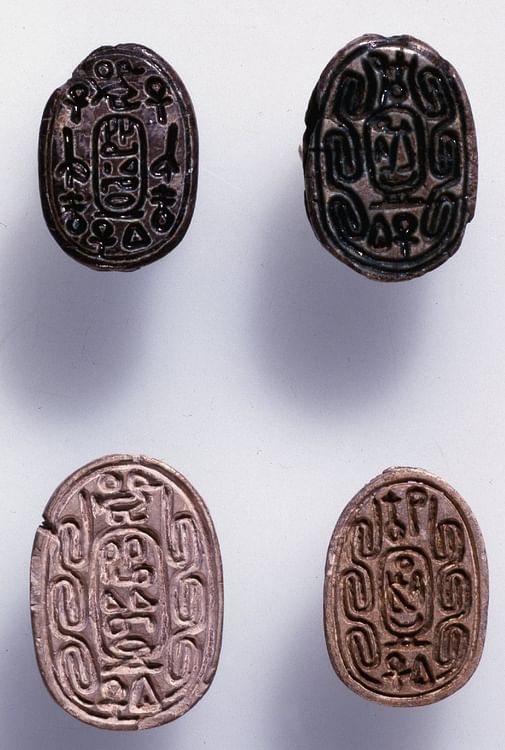
The Hyksos were a Semitic people who gained a foothold in Egypt c. 1782 BCE at the city of Avaris in Lower Egypt, thus initiating the era known in Egyptian history as the Second Intermediate Period (c. 1782 - c. 1570 BCE). Their name, Heqau-khasut, translates as 'Rulers of Foreign Lands' (given by the Greeks as Hyksos ), suggesting to some scholars that they were kings or nobility driven from their homes by invasion who found refuge in the port city of Avaris and managed to establish a strong power base during the decline of the 13th Dynasty of the Middle Kingdom (2040-1782 BCE). Most likely, they were traders who were at first welcomed at Avaris, prospered, and sent word to their friends and neighbors to come join them, resulting in a large population which was able to finally exert political and then military power.
Although the later Egyptian scribes of the New Kingdom (c. 1570-1069 BCE) would demonize the Hyksos as 'invaders' who conquered the land, destroyed temples, and slaughtered without mercy, there is no evidence for any of these claims. Even today, the Hyksos are referred to as invaders and their advent in Egypt as the 'Hyksos Invasion,' but actually, they assimilated neatly into Egyptian culture adopting Egyptian fashion and religious beliefs, with some modifications, as their own. Contrary to many claims throughout the years, there is no reason to identify the Hyksos with the Hurrians nor with the Hebrew slaves from the biblical Book of Exodus.
The main source of information on the Hyksos in Egypt comes from the 3rd century BCE Egyptian writer Manetho whose work has been lost but was extensively quoted by later writers, notably Flavius Josephus (37- c. 100 CE). Manetho's flawed understanding of the meaning of the Hyksos' name, and Josephus' further misinterpretation gives the translation of 'Hyksos' as 'captive shepherds,' and this complete misunderstanding has given rise in recent years to the claim that the Hyksos were a Hebrew community living in Egypt whose expulsion provides the basis for the events recorded in the Book of Exodus. There is no evidence, however, to support this claim. No Egyptian, nor any other culture's, records indicate the Hyksos were slaves in Egypt, and there is absolutely no indication they were Hebrew, only that they spoke and wrote a Semitic language. The ethnic origins of the Hyksos are unknown as is their fate once they were driven from Egypt by Ahmose I of Thebes (c. 1570-1544 BCE) who initiated the era of the New Kingdom of Egypt (c. 1570-1069 BCE).
THE ARRIVAL OF THE HYKSOS
For the greater part of Egypt's history, the country was insular even though foreigners regularly came to work in the country, serve as mercenaries, or were taken as slaves for the gold mines. Egyptians lived in the land of the gods, and those of lesser quality (regularly referred to as 'Asiatics') were off beyond the borders. The popular story of The Contendings of Horus and Setfrom the New Kingdom relates how, once the god Set is bested by Horus, he is given a kind of consolation prize of ruling over the desert regions beyond Egypt's borders. Set had murdered his brother, the god-king Osiris, and usurped the rule of Egypt.Osiris was brought back to life by his sister-wife Isis who bore his son Horus, the god who would eventually avenge his father and restore order to the land. The story's conclusion of placing Set outside of Egypt's borders is significant because Set was considered the god of chaos, darkness, storms and winds, and the Egyptians would have wanted such a deity as far from them as possible; out in the wilds where the 'other people,' the 'Asiatics,' would get the kind of god they deserved.
THE HYKSOS GAINED CONTROL OF THE EASTERN DELTA COMMERCIALLY & THEN MOVED NORTH MAKING TREATIES & FORGING CONTRACTS IN LOWER EGYPT UNTIL THEY WERE ABLE TO EXERT POLITICAL POWER.
Early campaigns by the Egyptian military, up until the time of the New Kingdom, were domestic for the most part, and when Egyptians did travel beyond their borders, it was never far. When the Hyksos first arrived, therefore, they would not have posed any great danger to Egyptian security because an actual threat from outside the country was simply unthinkable. By c.1782 BCE, Egypt had developed as a civilization for over 2,000 years, and the possibility of a people taking their country would have been dismissed as easily as a full-scale invasion of earth by flying saucers from Mars would be by most people today.
When the period of the Middle Kingdom began, Egypt was a strong, unified country. The king Amenemhat I (1991-1962 BCE), who founded the 12th Dynasty, was a strong, effective, ruler who, perhaps in an effort to further unify the country, moved the capital from Thebes (in Upper Egypt) to a middle ground between Upper and Lower Egypt near Lisht and named his new city Iti-tawi (also Itj-tawi ) which means "Amenemhat is he who takes possession of the Two Lands" (van de Mieroop, 101). He also founded the town of Hutwaret in Lower Egypt as a port of trade. Hutwaret (better known as Avaris, the Greek name) had access to the Mediterranean Sea and overland routes to the region of Syria - Palestine.
The 12th Dynasty is considered by many the high point of Egyptian culture and gives the Middle Kingdom its reputation as the 'classical age' of Egypt. The 13th Dynasty, however, was not as strong and made a number of ill-advised decisions which weakened their influence. The first of these mistakes was to move the capital from Iti-tawi back to Thebes in Upper Egypt. This decision essentially left Lower Egypt open to whatever power felt it had enough support to dominate it. The port town of Avaris, quickly expanding into a small city through commerce, attracted many of the people known to the Egyptians as 'Asiatics,' and as it flourished, their population grew. The Hyksos gained control of the eastern Delta commercially and then moved north making treaties and forging contracts with various nomarchs (governors) of other regions in Lower Egypt until they had taken a sizeable amount of the land and were able to exert political power.
THE HYKSOS IN EGYPT
Contrary to the claims of New Kingdom scribes, Manetho, Josephus - and even later historians of the 20th century CE - the Second Intermediate Period of Egypt was not a time of chaos and confusion, and the Hyksos did not conquer the whole of Egypt. Their influence extended only as far south as Abydos, and in the region of Lower Egypt, there were many cities, like Xois, which maintained their autonomy. The ruling class of Xois founded the Xoite Dynasty (the 14th Dynasty of Egypt) during the time of the Hyksos and traded regularly with both them and Thebes.
Josephus' account, relying heavily on Manetho's (who drew on the New Kingdom scribes) gives the impression that the Hyksos rolled into Egypt in their war chariots, laying waste to the land, and toppling the legitimate government. Again, there is no evidence for this; Egyptologist and historian Margaret Bunson explains:
The Hyksos did enter Egypt, but they did not appear there suddenly, with what Manetho termed "a blast of God".The Hyksos entered the Nile region gradually over a series of decades until the Egyptians realized the danger they posed in their midst. Most of the Asiatics came across Egypt's borders for centuries without causing much of a stir. (119)
Once they were established at Avaris, the Hyksos placed Egyptians in significant positions, adopted Egyptian custom and dress, and incorporated the worship of Egyptian gods into their own beliefs and rituals. Their chief gods were Baal and Anat, both of Phoenician/Canaanite/Syrian origin, but they identified Baal with the Egyptian Set.
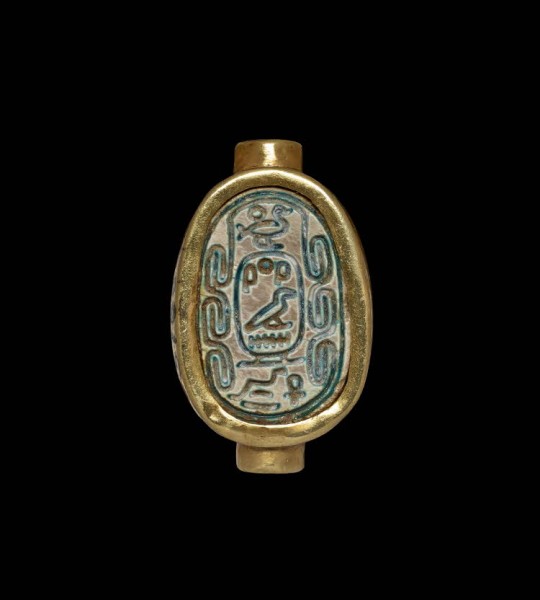
Cartouche of Khyan
The Hyksos rulers founded the 15th Dynasty of Egypt, but after they were expelled, all traces of the Hyksos in Egypt were erased by the conquering Thebans. Only a few Hyksos kings are known by name from the ruins of inscriptions, and other writings, found at Avaris and beyond: Sakir-Har, Khyan, Khamudi, and the best known, Apepi. Apepi was also known as Apophis and interestingly has an Egyptian name associated with the great serpent Apophis/Apep, enemy of the sun god Ra.It is possible that this king, who allegedly initiated the conflict between Avaris and Thebes, was so named by later scribes to associate him with danger and darkness.
There is nothing in the evidence which suggests that Apepi was either of those things. Trade flourished during the time of the Hyksos. Local governors of the cities and towns of Lower Egypt made treaties with the Hyksos, enjoyed profitable trade, and even Thebes, consistently depicted as the "last holdout" of Egyptian culture standing alone against the invader, had a cordial and seemingly profitable relationship with them, even though it does seem that Thebes paid tribute to Avaris.
AVARIS, THEBES & WAR
At the same time the Hyksos were gaining power in northern Egypt, the Nubians were doing so to the south. The 13th Dynasty of the Middle Kingdom had neglected to pay attention to their southern border just as they had with Lower Egypt. Thebes remained the capital of Upper Egypt but, instead of ruling the entire country, was sandwiched between the Hyksos in the north and the Nubians in the south. Still, Thebes and Avaris got along quite well. The Thebans were free to trade to the north, and the Hyksos sailed their ships past Thebes to buy and sell to the Nubians in the south. Trade went on between the Nubian capital of Kush, the Egyptian center at Thebes, and Avaris quite evenly until the Hyksos king - wittingly or unwittingly - insulted the king of Thebes.
There is no telling whether the story is true as given, but according to Manetho, Apepi of the Hyksos sent a message to the Theban king Seqenenra Taa (also known as Ta'O (c. 1580 BCE): "Do away with the hippopotamus pool which is on the east of the city, for they prevent me sleeping day and night." The message most likely had to do with the Theban practice of hippopotamus hunting, which would have been offensive to the Hyksos who incorporated the hippo in their religious observances through their worship of Set. Instead of complying with the request, Ta'O interpreted it as a challenge to his autonomy and marched on Avaris. His mummy shows he was killed in battle and this, and the events which follow, suggests the Thebans were defeated in this engagement.
Ta'O's son Kamose took up the cause, complaining bitterly in an inscription that he was tired of paying "the Asiatics" taxes and having to deal with foreigners to the north and south of him in his own land. He launched a massive strike against the Hyksos in which, according to his own account, Avaris was destroyed. Kamose claims that his attack was so swift and terrifying it made the Hyksos women suddenly sterile, and after the slaughter, he razed the city to the ground. This account would seem to be something of an exaggeration since the Hyksos still held Lower Egypt in the three years following Kamose's offensive and Avaris still stood as the Hyksos stronghold.
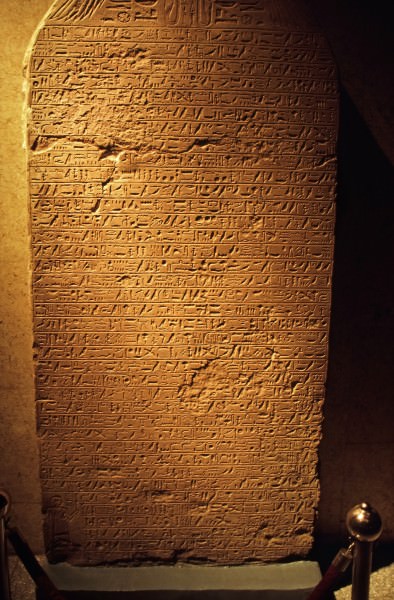
Stela of Kamose
Kamose was succeeded by his brother Ahmose, whose inscriptions describe how he drove the Hyksos from Egypt and destroyed their city of Avaris. These events are given in the tomb inscriptions of another man, Ahmose son of Ibana, a soldier who served under the king Ahmose, describing the destruction of Avaris and the flight of the surviving Hyksos to Sharuhen in the region of Palestine. This city was then placed under siege by Ahmose for six years until the Hyksos fled again, this time to Syria, but what happened to them after that is not recorded.
THE LEGACY OF THE HYKSOS IN EGYPT
Ahmose I not only founded the 18th Dynasty but initiated the period of the New Kingdom of Egypt, the era of the Egyptian empire. The development of a professional Egyptian army of conquest can be directly traced to the Hyksos in that Ahmose I, and those who followed him, wanted to make sure no foreign people would ever be able to gain such power in their land again.Beginning with Ahmose, and continuing on throughout the New Kingdom, the pharaohs created and maintained a buffer zone around Egypt which then encouraged them to conquer more lands beyond.
The Hyksos were vilified by the New Kingdom scribes to justify these wars of conquest and a new version of history was created in which the foreign invaders destroyed the temples of the gods, slaughtering the innocent and razing cities in a barbaric lust for conquest. Besides the fact that none of that happened, if it were not for the Hyksos, the Egyptian army would have been without two advantages which helped them establish their empire : the composite bow and the horse-drawn chariot.
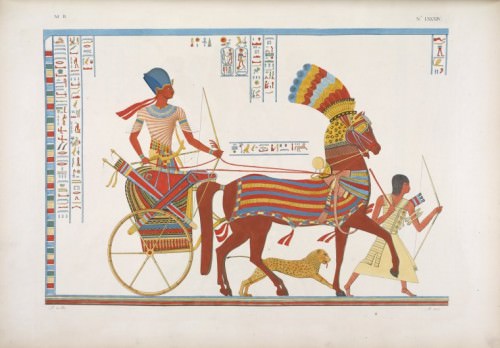
Egyptian War Chariot
Egyptian art from the New Kingdom regularly depicts the pharaoh, kings such as Tutankhamun or Ramesses II, in their chariot hunting with their dogs or going to war, and since the New Kingdom is the period most familiar to people in the present day, the chariot is associated with Egypt. The Egyptians had no knowledge of it, however, until it was introduced by the Hyksos. The composite bow, with much greater range and accuracy, replaced the Egyptian long bow that had been in use for centuries and the Hyksos also introduced the bronze dagger, the short sword, and many other innovations. New methods of crop irrigation were introduced to Egypt as well as metalworking in bronze. An improved potter's wheel resulted in higher quality ceramics which were also more durable. The Hyksos also brought to Egypt the vertical loom, which produced better quality linen, and new fruit and vegetable cultivation techniques.
The innovations of the Hyksos transformed the culture of Egypt but they also preserved the past. Under Apepi, old papyrus scrolls were copied and carefully stored and many of these are the only extant copies to have survived. They also united Egypt as never before through their depiction by New Kingdom scribes as blood-thirsty conquerors who had invaded the land of the gods. Egyptian nationalism was at an all-time high throughout most of the period of the New Kingdom, and aside from the new and improved weapons, Egypt's empire could never have risen without the belief that conquest was necessary to protect the people of Egypt from another tragedy which might be even more terrible than the invasion of the Hyksos.
LICENSE:
Article based on information obtained from these sources:with permission from the Website Ancient History Encyclopedia
Content is available under License Creative Commons: Attribution-NonCommercial-ShareAlike 3.0 Unported. CC-BY-NC-SA License